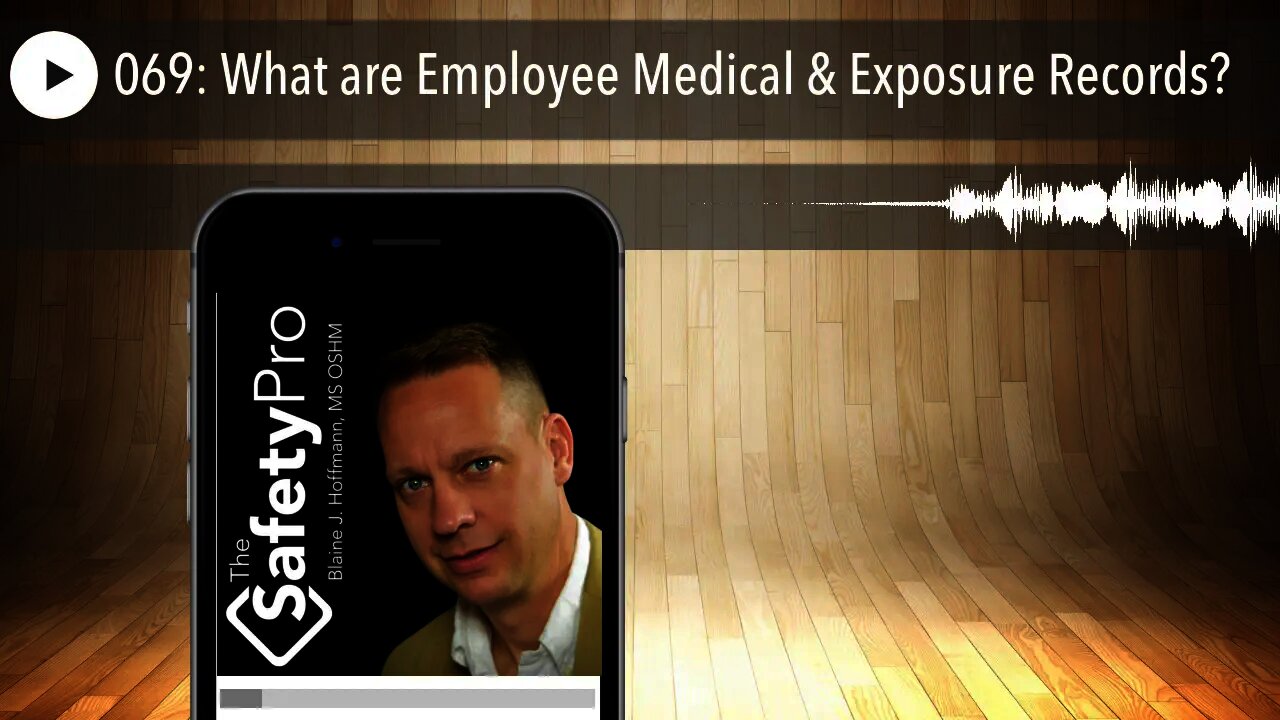Premium Only Content

069: What are Employee Medical & Exposure Records?
Subscribe here:
http://www.thesafetypropodcast.com
Powered by iReportSource
OSHA requires that employees who are or may be exposed to toxic substances or harmful physical agents be given access to their medical and exposure records. Further, OSHA requires that such records be maintained for a long period of time because often the symptoms of the illnesses that come from the exposure don’t appear until many years later.
OSHA’s requirement to maintain medical and exposure records applies to all employers who have employees exposed to toxic substances or harmful physical agents, such as heat, cold, radiation, repetitive motion, biological, chemical, etc.
• 29 CFR 1910.1020 — Access to employee exposure and medical records
Terms you need to know Access: means the right and opportunity to examine and copy. Designated representative: means any individual or organization to whom an employee gives written authorization to exercise a right of access. For the purposes of access to employee exposure records and analyses using exposure or medical records, a recognized or certified collective bargaining agent shall be treated automatically as a designated representative without regard to written employee authorization. Employee: means a current employee, a former employee, or an employee being assigned or transferred to work where there will be exposed to toxic substances or harmful physical agents. In the case of a deceased or legally incapacitated employee, the employee’s legal representative may directly exercise all the employee’s rights pertaining to this OSHA requirement. Employee exposure record: means a record containing any of the following kinds of information:
• Environmental (workplace) monitoring or measuring of a toxic substance or harmful physical agent, including personal, area, grab, wipe, or other forms of sampling, as well as related collection and analytical methodologies, calculations, and other background data relevant to the interpretation of the results obtained;
• Biological monitoring results which directly assess the absorption of a toxic substance or harmful physical agent by body systems (e.g., the level of a chemical in the blood, urine, breath, hair, fingernails, etc.) but not including results which assess the biological effect of a substance or agent or which assess an employee’s use of alcohol or drugs;
• Safety data sheets indicating that the material may pose a hazard to human health; or
• In the absence of the above, a chemical inventory or any other record which reveals where and when used and the identity (e.g., chemical, common, or trade name) of a toxic substance or harmful physical agent.
Employee medical record: means a record concerning the health status of an employee which is made or maintained by a physician, nurse, or other health care personnel, or technician, including:
• Medical and employment questionnaires or histories (including job description and occupational exposures),
• The results of medical examinations (pre-employment, pre-assignment, periodic, or episodic) and laboratory tests (including chest and other X-ray examinations taken for the purpose of establishing a base-line or detecting occupational illnesses and all biological monitoring not defined as an “employee exposure record”),
• Medical opinions, diagnoses, progress notes, and recommendations,
• First-aid records,
• Descriptions of treatments and prescriptions, and
• Employee medical complaints.
• Note: “Employee medical record” does not include medical information in the form of: (1) Physical specimens (e.g., blood or urine samples) which are routinely discarded as a part of normal medical practice; (2) Records concerning health insurance claims if maintained separately from the employer’s medical program and its records, and not accessible to the employer by employee name or other direct personal identifier (e.g., social security number, payroll number, etc.); (3) Records created solely in preparation for litigation which are privileged from discovery under the applicable rules of procedure or evidence; or (4) Records concerning voluntary employee assistance programs (alcohol, drug abuse, or personal counseling programs) if maintained separately from the employer’s medical program and its records.
Exposure or exposed: means that an employee is subjected to a toxic substance or harmful physical agent in the course of employment through any route of entry (inhalation, ingestion, skin contact or absorption, etc.), and includes past exposure and potential (e.g., accidental or possible) exposure, but does not include situations where the employer can demonstrate that the toxic substance or harmful physical agent is not used, handled, stored, generated, or present in the workplace in any manner different from typical non-occupational situations. Record: means any item, collection, or grouping of information regardless of the form or process by which it is ma
-
 1:12
1:12
KTNV
2 years agoBELLE MEDICAL MINUTE: What Causes Quarantine Weight Gain
24 -
 5:21
5:21
KMGH
3 years agoWhat Causes ED? // Ridge Side Medical CLinic
31 -
 1:13
1:13
KTNV
3 years agoBELLE MEDICAL MINUTE: What Causes Quarantine Weight Gain
16 -
 11:12
11:12
Rebel News
3 years ago $1.58 earnedCan your province share your medical records with Justin Trudeau?
6.1K59 -
 0:15
0:15
funfactz
3 years agoGuinness Book of Records holds what?
25 -
 59:38
59:38
The Tom Renz Show
16 hours ago"MAGA & Unity With Pastor Bernadette Smith"
8.34K1 -
 2:12
2:12
Memology 101
12 hours ago $2.35 earnedTYT's Cenk Uygur DESTROYS deluded self-proclaimed election Nostradamus over FAILED prediction "keys"
8.09K11 -
 2:11
2:11
BIG NEM
13 hours agoMeet the NATIVE Tribe Of The Balkans Nobody Talks About
4.94K2 -
 2:40:31
2:40:31
Fresh and Fit
11 hours agoAre You Smarter Than A 5th Grader? After Hours
185K74 -
 4:07:42
4:07:42
Alex Zedra
17 hours agoLIVE! Scary Games with the Girls
164K6